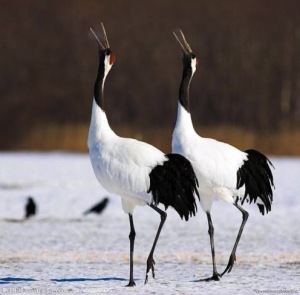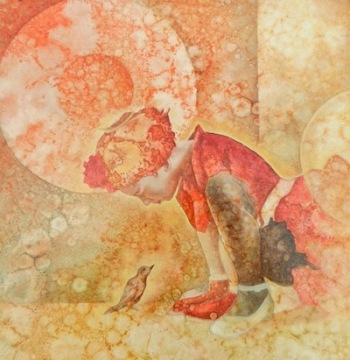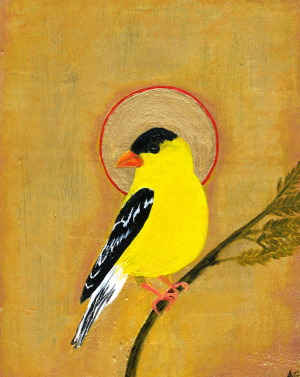An Iconography of Birds
In Tibet the Black-necked Crane is considered sacred.1
Cranes are stunning creatures, the world’s tallest flying birds, stepping delicately on impossibly long, thin legs as they forage with long beaks, then stopping to throw their heads back, bending back their also impossibly long necks to cry at the sky, dancing and jumping in courtship displays. In my part of the world, the upper Midwest in the U.S., migrating cranes (Sandhill and Whooping varieties) can be easily distinguished from herons in flight by noting the neck: cranes fly with neck outstretched while herons fold their necks into a gentle “S.”

Each summer the Black-necked Crane nests on the immense and forbidding Tibetan Plateau, raising its young, and then the flocks migrate to remote corners of India and Bhutan for the winter. Hidden over millennia by the forbidding landscape in which it makes its home, the Black-necked Crane holds the distinction of being the last crane, as far as we know, of course, to be identified by western science. Their “discovery” is dated back to 1876 when the Russian naturalist Count Przewalski spotted them near Lake Koko Nor in northeastern Tibet.
In the 17th century the Sixth Dalai Lama, Tsangyang Gyatso, became renowned for his poetry. His name means “Ocean of Pure Melody.” His was a troubled period in Tibetan history, and in 1706 when he was only 24 years old the Sixth Dalai Lama was captured by invading Mongol soldiers and never seen again. It was then that the lyrics of one his many songs took on added significance.
White crane!
Lend me your wings
I will not fly far
From Lithang, I shall return.
Tibetan Buddhists came to believe the words of the song were prophetic, an indication of his next reincarnation as Dalai Lama, when he would once again return to his people. The story became mythic when the Seventh Dalai Lama, Kelzang Gyatso, was identified, for he had been born in Lithang.
Creatures able to break free from what holds us to the surface of the earth to fly, dart, and soar effortlessly across the sky can seem to exist on the imaginative, mystical edge of ordinary reality. I remember when it seemed magical.
Little wonder that over the millennia birds have starred in the myths told from generation to generation. The renewing power of the Phoenix was woven into stories all over the ancient world — in Assyria, Egypt, India, China, and even the early Canaanites. The notion that the young would arise from the ashes of the old touches on a hope for redemption as old as fallen humanity, and was used to good effect by J.K. Rowling in the fifth book of her Harry Potter stories. The Tlingit of Alaska hold the raven in deep respect, believing the bird is resourceful and magical, able to bring blessing or cast an evil spell. They say that of all the creatures, the raven alone survived the great flood, piercing its bill into the sky and hanging there until the deadly water receded. The eagle was long associated with the Roman god Jupiter, signaling strength, cunning, and magisterial courage, and so was used by diverse leaders in world history from the Caesars to America’s founding fathers to Hitler as a symbol of power and empire. In the Navajo creation myth the owl appears, settling a fight between the sexes and allowing the formation of the human race. And somewhere along the way the stork became associated with fertility and good luck, allowing parents unwilling to tell their children about sex the excuse to say that storks bring babies to unsuspecting couples.
Shaping these myths are the perennial issues human beings must face: redemption and hope, dominance and submission, good and evil, and significance in the face of death. Neurologist Oliver Sacks captures in prose the need we feel to transcend an ordinary life that is shot through with brokenness.
To live on a day-to-day basis is insufficient for human beings; we need to transcend, transport, escape; we need meaning, understanding, and explanation; we need to see over-all patterns in our lives. We need hope, the sense of a future. And we need freedom (or, at least, the illusion of freedom) to get beyond ourselves, whether with telescopes and microscopes and our ever-burgeoning technology, or in states of mind that allow us to travel to other worlds, to rise above our immediate surroundings.
We may seek, too, a relaxing of inhibitions that makes it easier to bond with each other, or transports that make our consciousness of time and mortality easier to bear. We seek a holiday from our inner and outer restrictions, a more intense sense of the here and now, the beauty and value of the world we live in.
Many of us find Wordsworthian “intimations of immortality” in nature, art, creative thinking, or religion; some people can reach transcendent states through meditation or similar trance-inducing techniques, or through prayer and spiritual exercises.2

Shaun LaRose ©2010
That birds, with their riot of color and sound and an ability to fly, have come to be associated with the stories of our deeply human quest to explore such things only makes sense. They are our fellow creatures — dust to dust, ashes to ashes — yet manage to break free of the shackles of gravity and transcend the ground from which we are all made.
The opening lines of the Hebrew Scriptures picture the Spirit of God “hovering” over the waters (Genesis 1:2), an image all four apostolic writers brought into the New Testament in the story of Jesus’ baptism (Matthew 3:16; Mark 1:10; Luke 3:22; John 1:32). St Luke, a physician and careful observer, says that after Jesus “had been baptized and was praying, the heavens were opened, and the Holy Spirit descended on Him in bodily form, like a dove” (Luke 3:21–22). Which in turn echoes back to the Old Testament to the story told in so many cultures, of a great flood, when a dove signaled when it was safe to leave the ark after the water had gone down (Genesis 8:8–12). Centuries after that was recorded, Israel’s great King David, feared for his life, and like the Sixth Dalai Lama finds solace in the flying of a bird (Psalm 55:4–6):
My heart is in anguish within me;
the terrors of death have fallen upon me.
Fear and trembling come upon me,
and horror overwhelms me.
And I say, “Oh, that I had wings like a dove!
I would fly away and be at rest”
A generation later David’s son, Solomon, penned the gently erotic Song of Songs and mentions a bird pet name as he describes the night the lovers meet (5:2):
I slept, but my heart was awake.
A sound! My beloved is knocking.
“Open to me, my sister, my love,
my dove, my perfect one.”
She hesitates, and by the time she opens her door he has slipped away. Two other times in this epithalamium she is called his “dove,” evoking the image of soft beauty and a gentleness under which passion awaits.
In contrast, the Hebrew prophets conjured up visions of great ruins, once lively cities now destroyed and lying desolate. Here is the haunt of the hyena, and birds associated with decay, carrion, uncleanness, and a curse (Isaiah 34:10–11). Here, too, we find an echo in the New Testament with an image that is meant to chill our souls. The God of Scripture is not neutral about evil and is revealed instead as One who is angry at the wickedness His creatures have inflicted on one another and on His good world. I thought about this recently as I read a report of the horror inflicted on thousands of women and girls in the Congo where brutal militias are using systematic rape as a weapon of war, for I do not wish to worship a god who smiles benevolently at such things, a god who loves and does no more. No, I will not worship such a god, for such a god is not worthy of worship. I will only worship the God who sees through the forest canopy in the Congo and is so righteously angry that He sends an angelic messenger to scream an invitation to the birds:
Then I saw an angel standing in the sun, and with a loud voice he called to all the birds that fly directly overhead, “Come, gather for the great supper of God, to eat the flesh of kings, the flesh of captains, the flesh of mighty men, the flesh of horses and their riders, and the flesh of all men, both free and slave, both small and great.” (Revelation 19:17–18)
Justice is only possible when love exists, for only love is capable of paying an ultimate sacrifice to right a wrong.
The Biblical God of wrath is also revealed as gently caring for His world — not just for the big and obvious things, but for the hidden and humble as well. In 1st-century Palestine shoppers visiting the marketplace could buy two sparrows for a penny, or five for two pennies to save a bit of cash (Matthew 10:29–31; Luke 12:6–7). Sparrows are tiny unpretentious birds, yet not unnoticed by either Jesus (who called attention to the trade in sparrows) or His heavenly Father. Not a single sparrow hopping along the ground, Jesus said, could stumble or fall without the knowledge of the God who both created and sustained it. And if sparrows are noticed, Jesus added to his listeners, don’t you think you are loved by Him as well?
Sparrows are hedge-dwellers, so our backyard is well stocked with them, so much so that sometimes reading on the back porch is interrupted by the cacophony of their incessant single-note chirping. Where did they all come from? Though common in America, sparrows are native to Europe. Reports of their introduction into the U.S. conflict but at least agree that it occurred in the 19th century. One legend says that several pairs of the birds were imported, at considerable expense, by an English immigrant who wanted a reminder of the old country. Another legend says sparrows were introduced into Central Park to celebrate the birds mentioned in Shakespeare’s plays, which were running in New York City at the time. However it happened, the sparrows thrived.
On the front porch of our home, named Toad Hall by our children, in a corner near the ceiling a pair of lovely purple finches is raising a brood. The female laid five eggs but only three hatched. She cared for her young unflinchingly during one of the hottest weeks of this very hot summer, standing over her nest, beak open as though panting, her wings spread out as if to shelter them from the sun. As the three fledglings grew they pushed out the two unproductive eggs. The young grew feathers, welcomed their parents to the nest with gaping, begging mouths, and then one day flew away.
Hanging under the eave on our back porch is a little birdhouse into which a pair of chickadees moved. They raised a brood of eight young, and we occasionally dragged out the ladder from the garage to climb up, raise the birdhouse roof, and look briefly in at them. Slowly they changed from pink, bare-skin hatchlings into recognizable birds, always raising a holy ruckus when a parent arrived to stuff food down their scrawny throats. Then one day they were gone, the hedge lining the backyard suddenly filled with little chickadees noisily demanding to be fed. The parents looked bedraggled and unkempt by the end, and seemed to fly off suddenly as if they were trying to leave an ungrateful horde of adolescents behind. One day when I was watering a row of hostas that grow just beneath the hedge, the flock of chickadees appeared. The entire family kept hopping from branch to branch just outside the flow of water from my hose, singing and chirping, though never using their warning “dee-dee-dee” call.
After the chickadees moved out, a male wren, perky and loud, claimed the birdhouse. Wrens build nests of straws and sticks. We marveled as he repeatedly hauled a long twig to the opening, paused to maneuver it around until he grasped it by one end in his beak, and then plunged with it into the house. Male wrens build several such nests, apparently, and then sing to attract a female. She arrives to inspect each nest and if none meet her demanding specifications she moves on. The nest in our birdhouse was rejected, and we’ve only spotted the male occasionally, still alone.
Two seasons ago a pair of mourning doves nested in the spruce tree in our front yard. Then a very loud, pitch-black crow with a sharp beak attacked. Doves occasionally roost briefly in our yard, and I have often wondered if it is the same pair and whether they in some way known only to angels mourned their loss.

Anita Gorder ©2012
And then there are my favorites. Outside my office window as I type this essay a flock of goldfinches are squabbling over the perches on a thistle feeder. I confess that I think of them as “my” goldfinches, but of course nothing could be further from the truth. Each spring I trim the spruce tree so I have a clear view of the feeder from my desk, and filling the feeder with thistle seed is one of the chores I love performing. When I reach up into the branches with the long stick I made to hook and bring down the feeder, the finches all fly into higher branches and watch me, making their little distress call that sounds like a question. I am barely done and away by the time they are back on the perches, feeding. Some days, especially at the height of the summer when their young have left the nest and are following them fluttering their wings to beg to be fed, the flocks can empty the feeder in a day.
They are, for me, tiny, flashing, colorful glimpses of glory. Like tiny holes in the veil that lies between the seen and the unseen world, my goldfinches act as living metaphors, revealing that in a broken world grace exists so that hope is not hopeless. The One who is within Himself truth and goodness is also beauty, and relishes it since He lavished it on His creation in what looks to my eyes like riotous abandon. “Out of Zion,” the Hebrew poet wrote, “the perfection of beauty, God shines forth” (Psalm 50:2).
Most of the time that beauty is hidden from me. Perhaps that is because of my blindness, or because I allow myself to be overwhelmed by the darkness that infests the world and infects my heart. But then my yellow goldfinches appear, and I see it again. Just a momentary flash but it is enough. The brokenness is real, but it is not the final reality. The final reality is glory, and someday soon, a renewed earth will be resplendent with it.
And though I am no prophet, I’m pretty certain goldfinches will be part of it.
1 The idea for this piece was suggested by Ransom’s Resident Assistant, Anita Gorder. A fabric artist, she cares for Toad Hall’s yard, turning it into a little arboretum in the midst of a city. What she plants so lovingly helps draw the birds, so for that and for the idea to write about this, I am grateful.
2 Oliver Sacks, “Altered States,” The New Yorker (August 27, 2012), 40.

















